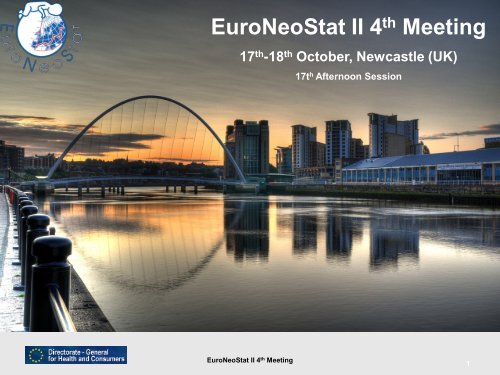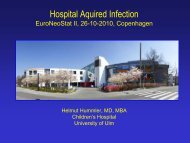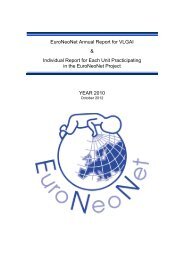EuroNeoStat II - Neonatal European Information System
EuroNeoStat II - Neonatal European Information System
EuroNeoStat II - Neonatal European Information System
You also want an ePaper? Increase the reach of your titles
YUMPU automatically turns print PDFs into web optimized ePapers that Google loves.
<strong>EuroNeoStat</strong> <strong>II</strong> 4 th Meeting17 th -18 th October, Newcastle (UK)17t h Afternoon Session<strong>EuroNeoStat</strong> <strong>II</strong> 4 th Meeting1
Welcome & PresentationsProject OverviewProf. Adolf Valls i Soler, BIOEF (Spain)<strong>EuroNeoStat</strong> <strong>II</strong> 4 th Meeting2
<strong>EuroNeoStat</strong> <strong>II</strong> 4 th SC MeetingOctober 17 th , 2011- SessionWelcome everyone√ 1. Excused their assistance. Nim Subhedar . Stan Craig. Olivier Claris . JI Pijoan. Marina Cuttini . Silke Mader√ 2. Invited persons. Henry Halliday . Matthias Keller. Mark Turner . Evelyne Jacqz-Aigrain. Agueda Azpeitia (funded by Spanish Ministry Science, ISCiii) 3. Presentation. Fernando de Miguel, BIOEF (instead of Mikel Alba)<strong>EuroNeoStat</strong> <strong>II</strong> 4 th Meeting3
Meeting Agenda Day 1EuroNeoNet Open Session17th OCTOBER 2011Welcome & Presentations15:00-15:15Invited people:Silke Mader (EFCNI)Matthias Keller, MD (EFCNI)Mark Turner, MD, PhD (NIHR-MCRN, University of Liverpool)Evelyne Jacqz-Aigrain, MD, PhDProf. Adolf Valls i Soler15:15-16:00Project OverviewReview of previous Meeting MinutesProject ResourcesAdministrative issues & Financial Report<strong>European</strong> Commission RequirementsAdministrative and Financial ProceduresProf. Adolf Valls i Soler&Fernando de Miguel16:00-16:30Work Package 8Patient SafetyMichael Weindling&Nim Subhedar16:30- 17:00 COFFEE BREAK17:00-19:00 Research Clinical Trials (RCT’s) Prof. Adolf Valls i Soler<strong>EuroNeoStat</strong> <strong>II</strong> 4 th Meeting4
Meeting Agenda Day 218th OCTOBER 201108:00-9:00Work package 5Standardized comparisonMrs. Agueda Azpeitia09:00-10:00Work package 7Hospital acquired infectionDr. Helmut Hummler&Prof. Adolf Valls i Soler10:00-10:30 COFFEE BREAK10:30-12:00Work package 6Follow-up indicatorsDr. Javier de la Cruz12:00-13:00Work package 9Building and assessing evidence-based actionsProf. Adolf Valls i Soler13:00:14:30 LUNCH14:30-15:00 Evaluation of the project Prof. Adolf Valls i Soler15:30-16:00 Conclusions<strong>EuroNeoStat</strong> <strong>II</strong> 4 th Meeting5
“Extended <strong>European</strong> <strong>Information</strong> <strong>System</strong> to Monitor Short-and Long-term Morbidity Outcomes to Improve Quality ofCare and Patient-Safety for VLBWI” (Proposal A/101106)“<strong>EuroNeoStat</strong> <strong>II</strong>” Agreement No. 2008 - 1311Project ends: Dec. 2012Plans for new funding !!!Partnership modification?<strong>EuroNeoStat</strong> <strong>II</strong> 4 th Meeting6
What have we done so far … 1(Since last meeting Paris April 2011)√ 1. BCC staff: External funds for full-time staff. 2011: Biostatistician (Spanish Science Min., ISCiii). Agueda Azpeitia (Biostatistitian) Funds secured for 2012!!. 2010-12: 2 Epidemiologist (in training):. Elena Santesteban (Pharmacist) GRIP project. Marisela Madrid (Microbiologist) SAMID Network√ 2. Rotation: . Alessandra Mularoni (Italian infection disease specialist). Grant from Italian Infection Diseases Society. Analysed our data on hospital-acquired infection. Ohiana Muga (neonatologist from San Sebastian). Analyse our data on BPD (will sent proposed protocol)<strong>EuroNeoStat</strong> <strong>II</strong> 4 th Meeting7
What have we done so far … 2√ 3. Publications- Submitted: . EOS: Pediatrics by Alessandra Mularoni & usADJ: resubmitted- “Cooking”:. Comparison NEOCOSUR Score: Ivonne. Hospital-acquired Infection: Alessandra. Seminal Reports Adolf (still pending..shame on me...)√ 4. Proposals for new scientific papers anyone?. Ohiana Muga: San Sebastian (BPD (will sent proposed protocol), Jon Mazela,: BPD, non specified aspects. Henry: Interactions: prenatal steroids, infection, surfactant, BPD. Agueda is willing to do stats or help yo. Can be sent data out???<strong>EuroNeoStat</strong> <strong>II</strong> 4 th Meeting8
√ 4. AbstractWhat have we done so far … 3Parallel Session 14.10.2011Topics: Ethics and Decision MakingChairpersons: Matthias Keller. University Hospital EssenMarta Thió, Royal Women’s Hospital, MelbourneNEONATAL MORTALITY RATE (NMR) IN VERY LOW BIRTH WEIGHTINFANTS (VLBWI). COMPARISON BETWEEN NEONATALNETWORKS FROM SPAIN (SEN1500) AND JAPAN (NRNJ)Adolf Valls-i-Soler on behalf of EuroNeoNet SCUniversity of Basque Country (UPV-EHU), Hospital de Cruces, Bilbao, Spain<strong>EuroNeoStat</strong> <strong>II</strong> 4 th Meeting9
What have we done so far … 5 5. Future dissemination meetings1. International Symposium of <strong>Neonatal</strong> MedicineStudy Group on <strong>Neonatal</strong> Respiratory Diseases. Guangzhou, November 10 th – 12th, 2011. Dr. Bo Sun, Shangai2. XX<strong>II</strong>I <strong>European</strong> Congress of Perinatal Medicine. Paris, June 13 th – 16 th , 2012. Prof. Umberto Simeoni, Marselle<strong>EuroNeoStat</strong> <strong>II</strong> 4 th Meeting10
What have we done so far … 6√ 6 Reports from meetingsEAP Tertiary Care Working Group, Brussels, Dec. 2010• Brief EuroNeoNet / <strong>EuroNeoStat</strong> presentation• Outcome:- Interest as Prove of Concept for other paediatric subspecialties- Invitation for this year for a full presentation?Update from Tom Stiris- ESPR/ESN: Is considering to propose membership to ENN as acriteria for teaching accreditation of <strong>European</strong> NICUs<strong>EuroNeoStat</strong> <strong>II</strong> 4 th Meeting11
What have we done so far … 7√ 7.1 Reports from collaboration with EFCONIEFCNI: <strong>European</strong> Foundation for the Care of Newborn Infants Silke Mader & Matthias Keller• White paper on Maternal and Child care in EuropeFacts and Figures on: 1) Pregnancy and Birth2) <strong>Neonatal</strong> Care4) Aftercare, follow-up- We decided to offer them: . to join our EuroNeoNet SC. To be partners in new projects<strong>EuroNeoStat</strong> <strong>II</strong> 4 th Meeting12
What have we done so far … 76.2 Reports from meetings<strong>EuroNeoStat</strong> <strong>II</strong> 4 th Meeting13
What we have done so far … 8√ 8. Reports from Collaborations GRIP projectGRIP (Global Research in Pediatrics) Roma, Feb 2011Funded by. 7 th FWRP. Call: Medicines for Children: Network of Excellence. Objective: Promotion of safer dugs for children & neonates• Co.chaired by: Carlo Giaquinto (PENTA,Padua)Steve Hirschfeld (NIH, Bethesda, MD)• Consortium: 19 partners: EMA, NICHD, WHO, NICH Japan ….<strong>EuroNeoStat</strong> <strong>II</strong> 4 th Meeting14
WP-6: NeonatologyCo. Leaders: . Evelyne Jack-Aigrain. Adolf Valls i SolerMain collaborator: . Mark TurnerSpecific objectives1. Identify neonatal networks2. Organize a training module in neonatal clinical pharmacology3. Identify common elements & standardised definitions for risk4. Inventory of un-adapted formulations & identify unmet needs5. Clarify role of animal studies in neonatal drug development for ND6. Standards for biological banking for PK, pharmacogenomic & proteomic7. To organise international consensus<strong>EuroNeoStat</strong> <strong>II</strong> 4 th Meeting
Identify common elements, definitionsTASKS: Harmonisation of datasets3.1 Report on Minim common dataset: items & definitions)3.2 Propose harmonise definitions & new items3.3 Queries, Delphi?, teleconferences, Consensus meeting1. VLBW /VLGA: Identify:1.1 Common items and definitions1.2 “ “ different “1.3 Select a few important non-equally define & non-existent items:(ex: GA, BW-GA intervals, CLD…)2. Other NN populations2.1 Near-term infants (GA>32 wks/BW>1500g)2.2 Term: asphyxia, surgery, death, late sepsis3. ND- follow-up (ENN) at 2 and 3-4 years<strong>EuroNeoStat</strong> <strong>II</strong> 4 th Meeting
What have we done so far … 9√ 9 Reports from meetingsMeeting at NICDH /NIH, Bethesda, MD, USASept. 9 th , 2011. Sponsor by: “The National Children´s Study” NICHDLead by Dr. Steven Hirschfield. Aim: Follow-up 100,000 pregnant women- children up to 21and Harmonise all terminology used for research in PediatricsAttendeds. Representatives from NN networks: NICHD, VON, CNN, ENN. Next step: . Compare outcomes used by different NNto identify items to be harmonised<strong>EuroNeoStat</strong> <strong>II</strong> 4 th Meeting17
What have we done so far … 1010 CollaborationsEnprEMA:. Accreditation Committee: Part of it but classified ENN as class 3. Unfulfilled criteria:4.1 Document for GCP guidelines: BCO4.7 QC & QA & data safety (Public): BCO5.4 Training course for RCT over last 2 yearsProposals:1. To develop a one-day RCT training course for the fall 20112. To develop a RCT Platform within EuroNeoNet<strong>EuroNeoStat</strong> <strong>II</strong> 4 th Meeting18
What have we done so far … 11one-day RCT training course for the fall 20111. Workshop on design of Paediatric Clinical Trials. Bilbao, October 22, 2011. Faculty: Mark Turner, Evelyne Jacqz-Aigrain, Sheelagh Corcoran.... Attended by: 60 persons, mainly Spanish neonatologists2. GCP Training Course. Faculty: Sheelagh Corcoran, TFS Academy. Accreditation: British Medical Association. Attended by: 24 persons, mainly Spanish neonatologists. Structure could be use for ESPR Pharmacology Section Precongresscourse in Estambul<strong>EuroNeoStat</strong> <strong>II</strong> 4 th Meeting19
• Already:Regional/National Networks• PNQ, Swedish National Registry• Northern Ireland NICU’s• SEN1500 (Spanish <strong>Neonatal</strong> Network)• Lazio Regional Network• Portuguese <strong>Neonatal</strong> Network• Near future:• Belgian <strong>Neonatal</strong> Network• Estonian <strong>Neonatal</strong> Network• Brittany Regional Network• : New NICUs: Denmark, Greece, Lathvia, Spain, France,Italy…<strong>EuroNeoStat</strong> <strong>II</strong> 4 th Meeting20
ENS <strong>II</strong> Work Packages (WP)• WP 1: Coordination of the Project• WP 2: Dissemination of the Results• WP 3: Evaluation of the Project• WP 4: Socio-economical indicators for health inequalities• WP 5: Standadised comparison of morbidity outcomes• WP 6: Minimal dataset for follow-up indicators at 3-4 years of age• WP 7: Specific dataset to study causes of hospital-acquiared infection• WP 8: EuroNeoSafe: Report for incidents and near-misses• WP 9: Building & assessing evidence-based actions on Quality of Care<strong>EuroNeoStat</strong> <strong>II</strong> 4 th Meeting21
ENS <strong>II</strong>: WP’s General timetable1 2 3 4 5 6 7 8 9 10 11 12 13 14 15 16 17 18 19 20 21 22 23 24 25 26 27 28 29 30 31 32 33 34 35 36WORKPACKAGENOV 09DEC 09JAN 10FEB 10MAR 10APR 10MAY 10JUNE 10JULY 10AUG 10SEP 10OCT 10NOV 10DEC 10JAN 11FEB 11MAR 11APR 11MAY 11JUNE 11JULY 11AUG 11SEP 11OCT 11NOV 11DEC 11JAN 12FEB 12MAR 12APR 12MAY 12JUNE 12JULY 12AUG 12SEP 12OCT 131 D1 D2 D32 D53 D44 D6 D95 D7 D8 D126 D67 D118 D69 D10TodayNext Meeting<strong>EuroNeoStat</strong> <strong>II</strong> 4 th Meeting22
• October 2011ENS <strong>II</strong> Present Deliverables• WP 5: Standardised comparison of morbidity outcomes: D8 (BIOEF)D8: Report on clinical variability encountered among NICUsENS <strong>II</strong> Uncoming Deliverables• October 2012• WP 4: Socio-economical indicators for health inequalities: D9 (OPBG)• WP 9: Building and assessing evidence-based actions to increase thequality of care and outcomes of VLBA/VLGA infants: D10 (BIOEF)D9: Report on health inequalities and its impact on health outcomesD10: Report on actions to improve the quality of care within EU NICUs.<strong>EuroNeoStat</strong> <strong>II</strong> 4 th Meeting23
Administrative issues &Financial reportFernando de Miguel, BIOEF (Spain)<strong>EuroNeoStat</strong> <strong>II</strong> 4 th Meeting24
WP 8: EuroNeoSafeMichael Weindling & Nim SubhdarLiverpool Woman’s Hospital,Liverpool (UK)<strong>EuroNeoStat</strong> <strong>II</strong> 4 th Meeting25
WP 8: EuroNeoSafe• Leader: UoL, Michael Weindling & Nim Subhdar• Specific objectives• Expansion of the <strong>Information</strong> <strong>System</strong>• Study of the indicators and actions to prevent adverse events• Deliverables• New list of indicators for patient’s safety (D6). Already SENT1 2 3 4 5 6 7 8 9 10 11 12 13 14 15 16 17 18 19 20 21 22 23 24 25 26 27 28 29 30 31 32 33 34 35 36WORKPACKAGENOV 09DEC 09JAN 10FEB 10MAR 10APR 10MAY 10JUNE 10JULY 10AUG 10SEP 10OCT 10NOV 10DEC 10JAN 11FEB 11MAR 11APR 11MAY 11JUNE 11JULY 11AUG 11SEP 11OCT 11NOV 11DEC 11JAN 12FEB 12MAR 12APR 12MAY 12JUNE 12JULY 12AUG 12SEP 12OCT 128 D6<strong>EuroNeoStat</strong> <strong>II</strong> 4 th Meeting26
EuroNeoNetResearch Clinical Trials PlatformAdolf Valls i Solerand all<strong>EuroNeoStat</strong> <strong>II</strong> 4 th Meeting27
What have we done so far … 10√ 10 CollaborationsEnprEMA:. Accreditation Committee: Part of it but classified ENN as class 3. Unfulfilled criteria:4.1 Document for GCP guidelines: BCO4.7 QC & QA & data safety (Public): BCO5.4 Training course for RCT over last 2 yearsProposals:1. To develop a one-day RCT training course for the fall 20112. To develop a RCT Platform within EuroNeoNet<strong>EuroNeoStat</strong> <strong>II</strong> 4 th Meeting28
EuroNeoNet.orgAims: 1) Quality-assessment of perinatal care VLBWI in Europe2) Safety initiative (“EuroNeoSafe” project)3) Quality improvement initiatives4) RCT Network• Methods . A common perinatal data-set, based VON (Copyright). Virtual environment by up-to-date technology• Participation: . >50 NICU´s from 16 countries. > 3.000 datasets/yearAffiliated to:• Partnerts: Claris O, Carnielli V, Corchia C, Cuttini M, de la Cruz J, HallidayH, Hallman M, Hummler H, Molendijk H, Pallás C, Sedin G + , Stiris T,Weindling M & Valls i Soler A<strong>EuroNeoStat</strong> <strong>II</strong> 4 th Meeting
EuroNeoTrial Platform• EuroNeoNet branch lead by: ENStat interested partners• Aims: To developed / conduct pharmacological & non-pharma.RCT in neonates at <strong>European</strong> level• Collaboration with GRIP partners:Evelyne Jacqz, Agrain Mark Turner+ other interested partners• Recognition: <strong>European</strong> level: EMA, ECRIN (EU)• Establish working relationships with other NR networks &groups around the world (NICHD RNN, ANZNN….<strong>EuroNeoStat</strong> <strong>II</strong> 4 th Meeting
EuroNeoNet opportunities for RCT1.Offered: . Prevention of NEC in VLBW infants. By use of probiotics(promoter undisclosed at this time)2. Approved by Spanish CAIBER:. Prevention of LOS in VLBW infants. Preventive structured intervention3. Collaboration GRIP: Participation & questionnaires4. Accreditation: By EMA<strong>EuroNeoStat</strong> <strong>II</strong> 4 th Meeting31
CAIBER. Spanish Platform RCTSpanish Ministry Science. ISCiiiEducational Intervention to Prevent Hospital-AcquiredInfections in Very Low Birth Weight Infants: A ClusterRandomised Controlled TrialEuroNeoKiss-Reference code: 1677-EKI-096Sponsor: UCICEC Hospital de Cruces (Barakaldo, Spain)Investigator Coordinators: A. Valls-i Soler & JI Pijoán
Study Design DiagramControl ArmSurveillance<strong>System</strong>Survey 1Surveillance <strong>System</strong>Survey 2Intervention ArmSurveillance <strong>System</strong> + InterventionSurvey 3Implementation0 1 2 3 4 5 6 7 8 9 10 11 12 13 14 15 16 17 18 19 20 21 22 23 24 25 26 27 28 29 30 31 32 33 34 35 36 37 38 39 40 41 42Period 1 Period 2 Period 3 Period 4Surveillance <strong>System</strong>Results FeedbackRandomizationPre Intervention PhaseInterventionImplementation PhaseInterventionEvaluation PhaseDataAnalysis
Educational Intervention to Prevent Hospital Acquired Infections in VeryLow Birth Weight Infants: A Cluster RCTSTUDY PHASES• Pre-intervention Ph (0-14 mo): Implementation in allNICUs a standardised, systematic NI surveillance systemspecific for VLBWI (EuroNeoKiss• <strong>II</strong>. Intervention Implementation Ph (15-27 mo):Implementation of evidence-based educational structuredpackage aimed at preventing NS in VLBWI (appliedlocally by a Q-improvement WG)• <strong>II</strong>I. Intervention Evaluation Ph (27-39 mo): Monitoringof effects of intervention on NI
Educational Intervention to Prevent Hospital Acquired Infections in VeryLow Birth Weight Infants: A Cluster RCTSAMPLE SIZE• Total number patients per arm 1,395 VLBWI(intra-class Co. coefficient 0.05; DE=3.5)• Estimating average No 50 VLBWI by NICU, 28NICUs must be included per arm• Expect losess 10%: Total No NICUs 32/arm (62)
Educational Intervention to Prevent Hospital Acquired Infections in VeryLow Birth Weight Infants: A Cluster RCTOUTCOMES• Primary Outcome: Incidence of microbiologicallyconfirmedNS and/or meningitis• Secondary outcomes:√• Individual: demographics, risk/protective prenatal factors, neonatalinterventions, co-morbidities and mortality• Practice & Procedures: End of surveillance, patient days, CVC, PVC days,intubation days, CPAP days, antibiotics days• Infection: Incidence Clinical NS/meningitis• Intervention variables: Related with all the evidence-based educationalintervention strategy designed by each NICU.• Unit (clusters): “membership survey” designed by ENN
EuroNeoNet RCT Platform• Is it a good idea?• Is it needed?• Is it feasible?• Is it the right time?• Who is interested?• Should be set a specific WG to push it forward?• What is the best strategy to set it?i) Start by developing 1-2 RCT as “poulbrove-of-concept”. Could we use EuroNeoKiss?NICUs: Spain 35? Portugal 15 + others?. Any other ideas about RCT at this time?ii) Start by developing an infrastructure. Difficulties in financing. Opportunities with GRIP. Can we learn from others?
EuroNeoNetResearch Clinical Trials PlatformTopic open for discussion1. Is it a good idea?2. Is it needed?3. Is it feasible?4. Who is interested?5. Should we start by developing a RCT?6. Need to plan for an infrastructure?7. ..........<strong>EuroNeoStat</strong> <strong>II</strong> 4 th Meeting38





